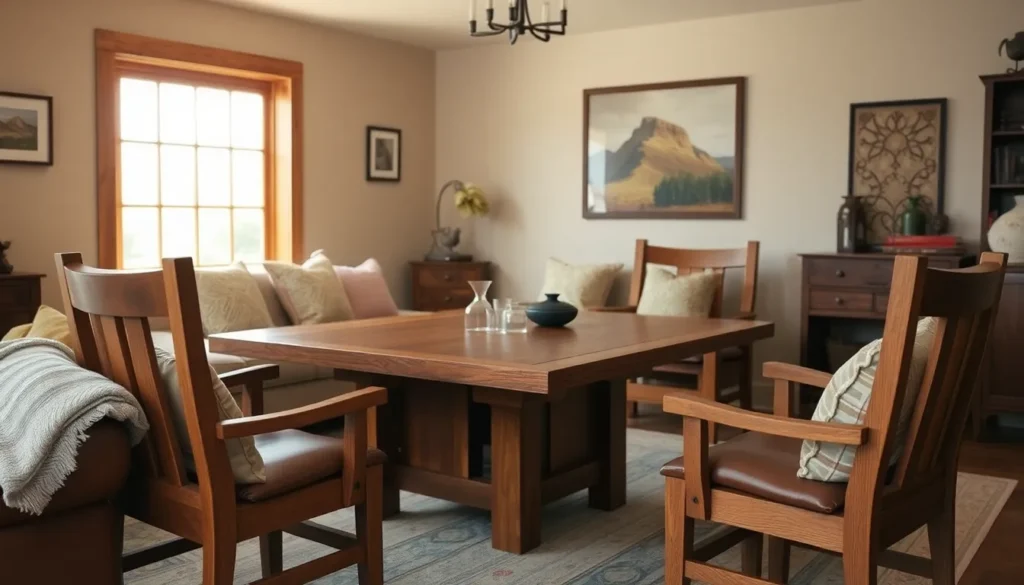Table of Contents
ToggleImagine a world where furniture isn’t just functional but also a feast for the eyes. Enter arts and crafts style furniture, a design movement that champions craftsmanship and simplicity. This isn’t your run-of-the-mill, mass-produced stuff; it’s the kind of furniture that whispers stories of artisans pouring their heart and soul into every piece.
With its clean lines and natural materials, arts and crafts style furniture invites you to kick back and appreciate the beauty of the handmade. It’s like the cozy sweater of home decor—warm, inviting, and just a little quirky. Whether you’re a design aficionado or someone who just wants to impress their in-laws, this style has something for everyone. So grab your favorite drink and settle in as we explore why this timeless aesthetic deserves a place in your home.
Overview of Arts and Crafts Style Furniture
Arts and crafts style furniture showcases craftsmanship and simplicity, prioritizing quality materials and skilled artisanship. This design movement emerged in the late 19th century as a reaction against mass production. Each piece tells a unique story, reflecting the individuality of the maker. Walnut, oak, and mahogany often serve as preferred materials, emphasizing durability and beauty.
Furniture forms in this style include sturdy chairs, solid tables, and elegant cabinets. Clean lines and minimal adornment characterize the designs, providing a timeless appeal. Natural finishes enhance the wood’s inherent grain, adding warmth to any space. The aesthetic encourages a connection to nature, promoting an earthy, calming environment.
Versatility defines arts and crafts style furniture. It fits comfortably within various home decor themes, from rustic to modern. Ideal for both design enthusiasts and casual decorators, pieces suit different tastes while harmonizing with diverse surroundings.
Cushions and textiles often complement furniture, adding softness to the overall look. Patterns tend to be subtle, reinforcing simplicity while improving comfort. Lighting fixtures, such as table lamps and sconces, frequently reflect the same craftsmanship principles, further unifying the aesthetic.
Incorporating arts and crafts style furniture creates an inviting atmosphere. Heirloom quality ensures longevity, allowing pieces to be passed down through generations. Homeowners appreciate the blend of functionality and artistry, making it a lasting choice in interior design.
Key Characteristics

Arts and crafts style furniture showcases distinct characteristics that set it apart from contemporary designs. This style focuses heavily on craftsmanship and natural materials.
Materials Used
Wood serves as the primary material, with oak, walnut, and mahogany leading in popularity. Each type brings its own warmth and durability, making it ideal for furniture. Expert artisans select high-quality, sustainable woods that highlight the material’s natural beauty. Other options like leather and metal may occur, enhancing texture and strength. These materials contribute to the aesthetic while ensuring each piece lasts for generations.
Design Elements
Simplicity defines the design elements found in arts and crafts furniture. Clean lines create a sophisticated look, while minimal ornamentation keeps the focus on craftsmanship. Furniture forms include sturdy tables, comfortable chairs, and elegant cabinets that enhance functionality. Natural finishes accentuate the wood grain, fostering a connection to the outdoors. This style favors geometric shapes and asymmetry, promoting visual balance without excessive decoration. Elements like exposed joinery highlight the construction method, ensuring each piece tells its own unique story.
History of Arts and Crafts Movement
The Arts and Crafts Movement originated in the late 19th century. It emerged as a response to the Industrial Revolution’s focus on mass production.
Influential Designers
Key figures like William Morris and Gustav Stickley shaped the movement. Morris championed craftsmanship through decorative arts and textiles, while Stickley popularized rustic furniture designs. Each designer emphasized simplicity and function, aiming to return to traditional craftsmanship. Their work reflects a desire for authenticity, fostering appreciation for handmade pieces.
Impact on Furniture Design
Furniture design underwent significant changes during this era. Emphasis on quality, durability, and natural materials became prominent. Craftsmen focused on creating timeless pieces that stressed functionality over excess decoration. The rise of exposed joinery highlighted construction methods, enabling pieces to communicate their stories. This shift encouraged future designers to prioritize craftsmanship and sustainability in their work.
Popular Types of Arts and Crafts Style Furniture
Arts and crafts style furniture includes a variety of pieces, each showcasing unique craftsmanship and quality materials. This section explores the most popular types.
Chairs and Seating
Chairs in the arts and crafts style emphasize comfort and durability. Rocking chairs often feature thick wooden frames and curved backs, providing a cozy seating option. Side chairs typically display simple lines, accentuating the natural wood grain. Armchairs offer additional support, with wide arms that invite relaxation. Many craftsmen incorporate leather or cotton upholstery to enhance the seating experience, ensuring durability without compromising style. Each chair reflects the artisan’s attention to detail, making these pieces not just functional but also visually appealing.
Tables and Desks
Tables serve as focal points in arts and crafts design, with each piece emphasizing solid construction. Dining tables usually showcase large, sturdy forms, highlighting the beauty of the wood grain. Coffee tables often come with simple silhouettes, ensuring they complement rather than compete with other decor elements. Desks in this style prioritize function, featuring built-in storage solutions and straightforward design aesthetics. The surfaces typically exhibit a rich finish that accentuates the natural beauty of the hardwood. Each table and desk embodies craftsmanship, offering both practicality and timeless elegance.
Caring for Arts and Crafts Style Furniture
Caring for arts and crafts style furniture requires attention to detail and a few essential practices. Regular dusting keeps the surfaces clean and prevents buildup that can scratch the wood. Use a soft, lint-free cloth to gently wipe away dust and debris.
Cleaning spills promptly helps maintain the finish. If a liquid accidentally spills, blot it with a clean cloth instead of wiping, which could spread the stain. For deeper cleaning, use a mild soap solution and follow with a damp cloth, ensuring no excess water remains on the wood.
Humidity levels play a crucial role in preserving the integrity of wood materials. Keep indoor humidity between 40% and 60% to minimize expansion or contraction. If necessary, utilize a humidifier during dry seasons to maintain stable moisture levels.
Applying furniture polish enhances the wood’s natural beauty. Use a high-quality, natural wax or furniture oil every six months to nourish the wood. Apply it thinly, following the grain, and buff with a clean cloth after drying for a radiant shine.
Direct sunlight can cause fading over time. Position furniture away from windows or use curtains to block harsh rays. Additionally, rotating furniture periodically helps prevent uneven wear, especially for high-traffic pieces.
Repairs prompt attention if minor damage occurs. Check for scratches or dents; these can often be treated with a touch-up marker or wood filler. For more significant repairs, seek professional restoration to maintain the artisan quality.
These maintenance strategies support the longevity and aesthetic appeal of arts and crafts style furniture, enabling it to remain a cherished part of home decor for years.
Arts and crafts style furniture stands as a testament to quality craftsmanship and timeless design. Its focus on natural materials and simplicity creates pieces that not only serve a function but also tell a story. This aesthetic appeals to those seeking warmth and character in their homes.
By embracing the principles of the Arts and Crafts Movement, modern designers continue to honor tradition while adapting to contemporary needs. The enduring popularity of this style reflects a desire for authenticity and connection to nature in interior spaces. With proper care, arts and crafts furniture can remain a cherished part of home decor for generations, embodying both beauty and durability.








